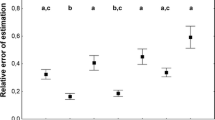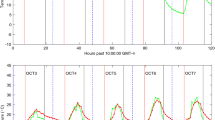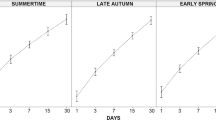Abstract
To produce postmortem interval estimations, forensic experts are often required to model weather conditions prior to the discovery of a cadaver by linking records from a regional meteorological weather station and an on-site portable weather station. Sometimes, however, cadavers are concealed within containers that will not automatically conform to the ambient temperature, thus making modeling more complex. Here, we have examined the factors influencing the modeling of weather data for carcasses concealed in suitcases, trash cans, and sealable drums. Results showed that in situ temperature modeling was facilitated by the use of additive models accounting for the non-linear effect of the time of day due to delays in temperature oscillations between the meteorological weather station and the study site. The containers concealing a carcass tended to be warmer than the ambient air and increased in temperature with a delay when ambient air temperature was hot, especially for less permeable containers. Containers that allowed fly larvae or adults to access the carcass (i.e., suitcases and trash cans) exhibited higher temperatures at smaller postmortem interval values than sealed containers (i.e., drums), which was likely caused by a maggot mass effect. The data collected improve our understanding of the phenomena affecting the modeling of in situ temperature records and of the microhabitat of concealed carcasses. Based on the results, we stress that when forensic modeling involves two sequential steps (i.e., in situ temperature modeling followed by the use of insect developmental curves, decomposition scores, algor mortis equations, etc.), close attention should be given to the first step because its deficiency limits the quality of the predictions from the subsequent step.





Similar content being viewed by others
References
Ahmad, A., Ahmad, A. H., Dieng, H., Satho, T., Ahmad, H., Aziz, A. T., et al. (2011). Cadaver wrapping and arrival performance of adult flies in an oil palm plantation in northern Peninsular Malaysia. Journal of Medical Entomology, 48, 1236–1246.
Amendt, J., Campobasso, C. P., Gaudry, E., Reiter, C., LeBlanc, H. N., & Hall, M. J. (2007). Best practice in forensic entomology—Standards and guidelines. International Journal of Legal Medicine, 121, 90–104.
Archer, M. S. (2004). The effect of time after body discovery on the accuracy of retrospective weather station ambient temperature corrections in forensic entomology. Journal of Forensic Sciences, 49, 553–559.
Baqué, M., & Amendt, J. (2013). Strengthen forensic entomology in court—the need for data exploration and the validation of a generalised additive mixed model. International Journal of Legal Medicine, 127, 213–223.
Bhadra, P., Hart, A. J., & Hall, M. J. R. (2014). Factors affecting accessibility to blowflies of bodies disposed in suitcases. Forensic Science International, 239, 62–72.
Bugelli, V. D., Forni, L. A., Bassi, M., Di Paolo, D., Marra, S., Lenzi, C., et al. (2015). Forensic entomology and the estimation of the minimum time since death in indoor cases. Journal of Forensic Science, 60, 525–531.
Byrd, J. H., & Allen, J. C. (2001). The development of the black blow fly, Phormia regina (Meigen). Forensic Science International, 120, 79–88.
Campobasso, C. P., Di Vella, G., & Introna, F. (2001). Factors affecting decomposition and Diptera colonization. Forensic Science International, 120, 18–27.
Catts, E. P. (1992). Problems in estimating the postmortem interval in death investigations. Journal of Agricultural Entomology, 9, 245–255.
Charabidze, D., Bourel, B., & Gosset, D. (2011). Larval-mass effect: characterisation of heat emission by necrophageous blowflies (Diptera: Calliphoridae) larval aggregates. Forensic Science International, 211, 61–66.
Cianci, T. J., & Sheldon, J. K. (1990). Endothermic generation by blow fly larvae Phormia regina developing in pig carcasses. Bulletin of the Society for Vector Ecology, 15, 33–40.
Dabbs, G. R. (2015). How should forensic anthropologists correct National weather service temperature data for use in estimating the postmortem interval? Journal of Forensic Sciences, 60, 581–587.
Dolinak, D., Matshes, E., & Lew, E. O. (2005). Forensic pathology: principles and practice. Amsterdam: Elsevier.
Dourel, L., Pasquerault, T., Gaudry, E., & Vincent, B. (2010). Using estimated on-site ambient temperature has uncertain benefit when estimating postmortem interval. Psyche, 2010, 1–7.
Goff, M. L. (1992). Problems in estimation of postmortem interval resulting from wrapping of the corpose. A case study from Hawaii. Journal of Agricultural Entomology, 9, 237–243.
Grassberger, M., & Reiter, C. (2002). Effect of temperature on development of the forensically important holarctic blowfly Protophormia terraenovae (Robineau–Desvoidy) (Diptera: Calliphoridae). Forensic Science International, 128, 177–182.
Greenberg, B. (1991). Flies as forensic indicators. Journal of Medical Entomology, 28, 565–577.
Hastie, T. J., & Tibshirani, R. J. (1990). Generalized additive models, volume 43 of monographs on statistics and applied probability. London: Chapman & Hall.
Jahnke, C. C., Subramanyan, V., & Valentine, D. T. (1998). On the convection in an enclosed container with unstable side wall temperature distributions. International Journal of Heat and Mass Transfer, 41, 2307–2320.
Janaway, R. C., Percival, S. L., & Wilson, A. S. (2009). Decomposition of human remains. Microbiology and aging (pp. 313–334). London: Springer.
Johnson, A. P., Wallman, J. F., & Archer, M. S. (2012). Experimental and casework validation of ambient temperature corrections in forensic entomology. Journal of Forensic Sciences, 57, 215–221.
Kelly, J. A., Linde, T. C. V. D., & Anderson, G. S. (2011). The influence of clothing and weapping on carcass decomposition and arthropod succession during the warmer seasons in Central South Africa. Journal of Forensic Sciences, 54, 1105–1112.
Lutz, L., Amendt, J., & Moreau, G. (2018). Carcass concealment alters assemblages and reproduction of forensically important beetles. Forensic Science International, 291, 124–132.
Megyesi, M., Nawrocki, S., & Haskell, N. (2005). Using accumulated degree-days to estimate the postmortem interval from decomposed human remains. Journal of Forensic Sciences, 50, 1–9.
Michaud, J.-P., & Moreau, G. (2009). Predicting the visitation of carcasses by carrion-related insects under different rates of degree-day accumulation. Forensic Science International, 185, 78–83.
Michaud, J.-P., & Moreau, G. (2017). Facilitation may not be an adequate mechanism of community succession on carrion. Oecologia, 183, 1143–1153.
Michaud, J.-P., Schoenly, K. G., & Moreau, G. (2012). Sampling flies or sampling flaws? Experimental design and inference strength in forensic entomology. Journal of Medical Entomology, 49, 1–10.
Moreau, G., Michaud, J.-P., & Schoenly, K. G. (2015). Experimental design, statistics and computer modeling. International dimensions and frontiers of forensic entomology (pp. 205–230). Boca Raton: Taylor & Francis Books Inc.
R Core Team (2017). R: A language and environment for statistical computing. Vienna: R Foundation for Statistical Computing.
Rodriguez, W., 3rd, & Bass, W. M. (1985). Decomposition of buried bodies and methods that may aid in their location. Journal of Forensic Sciences, 30, 836–852.
Scala, J. R., & Wallace, J. R. (2010). The application of weather and climate, in forensic entomology: The utility of arthropods in legal investigations (2nd ed., pp. 519–539). Boca Raton: CRC Press.
Schoenly, K. G., Michaud, J.-P., & Moreau, G. (2015). Design and analysis of carrion field. Carrion ecology, evolution, and their applications (pp. 129–150). Boca Raton: CRC Press.
Shin, S. E., Jang, M. S., Park, J. H., & Park, S. H. (2015). A forensic entomology case estimating the minimum postmortem interval using the distribution of fly pupae in fallow ground and maggots with freezing injury, Korean. Journal of Legal Medicine, 39, 17–21.
Tarone, A. M., & Foran, D. R. (2008). Generalized additive models and Lucilia sericata growth: Assessing confidence intervals and error rates in forensic entomology. Journal of Forensic Sciences, 53, 942–948.
Tsokos, M., & Byard, R. W. (2012). Putrefactive “rigor mortis. Forensic Science, Medicine, and Pathology, 8, 200–201.
Vanin, S., Tasinato, P., Ducolin, G., Terranova, C., Zancaner, S., Montisci, M., et al. (2008). Use of Lucilia species for forensic investigations in Southern Europe. Forensic Science International, 177, 37–41.
Vass, A. A. (2011). The elusive universal post-mortem interval formula. Forensic Science International, 204, 34–40.
Voss, S. C., Forbes, S. L., & Dadour, I. R. (2008). Decomposition and insect succession on cadavers inside a vehicle environment. Forensic science, Medicine, and Pathology, 4, 22–32.
Acknowledgements
The authors would like to thank B. Chiasson, L. Tousignant and two anonymous reviewers for comments on an earlier version of the manuscript; F. Gandiaga, S. Lamarre, M.-S. Morneau, A. Mourant, and M. Thibault for assistance during fieldwork; J.-P. Privé, for access to the study site; T. Van Der Brand for help with the carcasses; G. Fortin for the data loggers; and NSERC for financial support.
Author information
Authors and Affiliations
Corresponding author
Additional information
Publisher's Note
Springer Nature remains neutral with regard to jurisdictional claims in published maps and institutional affiliations.
Electronic supplementary material
Below is the link to the electronic supplementary material.
Rights and permissions
About this article
Cite this article
Moreau, G., Lutz, L. & Amendt, J. Honey, Can You Take Out the Garbage Can? Modeling Weather Data for Cadavers Found Within Containers. Pure Appl. Geophys. 178, 745–756 (2021). https://doi.org/10.1007/s00024-019-02105-7
Received:
Revised:
Accepted:
Published:
Issue Date:
DOI: https://doi.org/10.1007/s00024-019-02105-7




